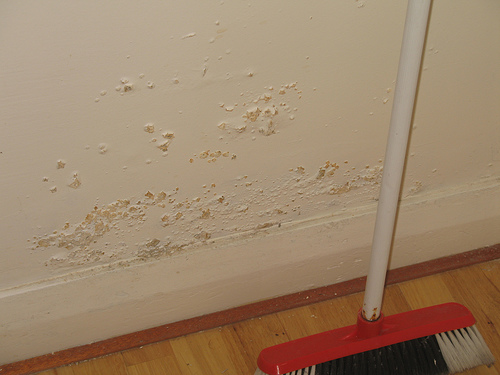
Rising Damp in Perth
What is Rising Damp?
Rising damp occurs when moisture is drawn up through a masonry wall in a capillary action. For rising damp to occur the section of the wall must be greater than that of the ground. The majority of buildings are constructed incorporating a physical damp proof course at a level of around 150m above ground-level externally and at ground level internally to prevent ground water from rising up the walls of a building.
If this damp proof course is damaged, bridged or deteriorates then rising damp may occur, affecting the health of the occupants and depositing soluble ground-water salts that grow as crystals and cause damage to the internal plaster.
The normal limit for rising damp ranks from 0.5 – 1.5 metres above ground level, dependent upon the
permeability of the affected structure.
A Brief History
The issue of rising damp has been a concern. Since ancient times the Roman architect “Vitruvius” referred to the problem of dampness rising up walls and advised on how to construct buildings to avoid this. Eventually the
Public Health Act of 1875 in Victorian Britain introduced the requirement for a damp proof course in walls to
prevent rising damp.
Health Implications
Rising damp in buildings leads to the growth of microbes such as mould, fungi and bacteria, which subsequently emit spores, cells, fragments and volatile organic compounds into the indoor air. Exposure to these
contaminants is clinically associated with respiratory symptoms, allergies, asthma and immunisation reactions.
Diagnosis
Diagnosis can often be made by the forming of a visual band of soluble “tide mark” at the peak of the damp’s rise. If this is not present, then the use of a moisture meter will normally suffice with moisture content within the wall becoming gradually higher as you gravitate towards ground level. Caution should be exercised to eliminate penetrating damp issues such as a blockage within a cavity wall.
Rectification
In order to cure a rising damp problem, a new form of damp proof coursing must be installed. This may be achieved by utilising one of the following methods:
• Installing a new physical damp proof course.
• Injection of a liquid or cream chemical damp proof course (DPC injection).
• Damp proofing rods.
• Porous tubes/other evaporative methods (e.g schrijver system).
• Land drainage.
• Electrical-osmotic systems.
Once the chosen method of rectification has been implemented, the existing salt-affected plaster will require
removal, usually to a height of approximately 350mm above excessive moisture readings which is normally
approximately 1 metre above internal ground level.
Re-plastering and re-decorating times are the subject of much debated, however I believe that it is advisable to trust your main contractor’s judgement, provided that the terms of the warranty also align with this.
As it is not possible to skim over the white-set finish plaster used in Perth, a little creativity should be used to
ensure a perfect and yet cost-effective finish. If the plasterer and painter are able to ensure you of a perfect, seamless finish between new and existing then this would be the best scenario, otherwise alternatives to
consider include:
• Removal of the white-set plaster above level of re-plastering to facilitate white setting of the full walls.
• Dry lining/plasterboard application to walls.
• The use of dado rails to provide separation of old and new plasterwork.
• Wallpapering.
• Total re-plastering of all affected walls.
Each of these methods have plus and minus points and carry different levels of expenditure. Be sure to
undertake your due diligence before you commit.
If you have concerns that the property you’re purchasing may be affected by rising damp, contact
Cap-It-All Building Inspections today, so we can undertake an inspection of the property and offer you
best advice.
